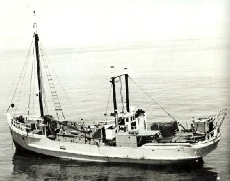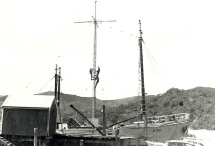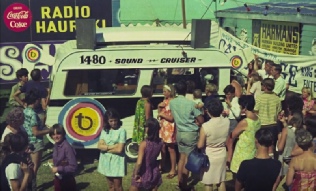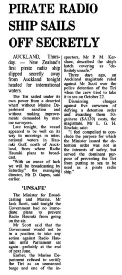© 2014-


Radio Hauraki - History (5)
This time the departure plan went like clockwork, with the Tiri sailing into the open sea before anyone in authority realised that she had gone. Finally at 6.30am on 11th November 1966 the Tiri dropped anchor at her mooring in the triangle of international waters within the Hauraki Gulf.
After having waited for so long to sail its vessel out to sea the planned timetable for launching Radio Hauraki was a tight one -
With the aerial mast still in pre- y aerial by stringing hundreds of metres of wire between the ship's own masts. Unfortunately this work on the aerial as well as tuning the station's transmitter took much longer than had been anticipated and the planned 6.00am opening of Radio Hauraki was not achieved. It was not until 5.00pm that day, 12th November 1966, that everything was ready for the first test broadcast to start, then just as power was fed to the transmitter an output valve blew and with no spares on board the ship Radio Hauraki was forced to remain silent.
y aerial by stringing hundreds of metres of wire between the ship's own masts. Unfortunately this work on the aerial as well as tuning the station's transmitter took much longer than had been anticipated and the planned 6.00am opening of Radio Hauraki was not achieved. It was not until 5.00pm that day, 12th November 1966, that everything was ready for the first test broadcast to start, then just as power was fed to the transmitter an output valve blew and with no spares on board the ship Radio Hauraki was forced to remain silent.
During the night and much of the following day a severe storm tossed the Tiri at her anchorage and after about 48 hours the Radio Hauraki crew renewed their efforts to put the station on the air. However, there were further unexpected transmitter problems and it was not until a week later -
On 24th November 1966 the radio ship tied up at Port Tryphena on Great Barrier Island to enable the crew to erect the aerial mast. Over 100' of mast was erected, which together with a 30' telescopic aerial, was considered sufficient to produce a good signal for the station's target area. During the evening of 1st December 1966 the Tiri sailed back to her anchorage in the Coleville Channel and at about 8.00pm test transmissions were resumed. This time the signal was loud and clear throughout Auckland and the surrounding area.
Island to enable the crew to erect the aerial mast. Over 100' of mast was erected, which together with a 30' telescopic aerial, was considered sufficient to produce a good signal for the station's target area. During the evening of 1st December 1966 the Tiri sailed back to her anchorage in the Coleville Channel and at about 8.00pm test transmissions were resumed. This time the signal was loud and clear throughout Auckland and the surrounding area.
Success was short-
Once in port the crew set about erecting a replacement mast, using a spare 50' section of the original structure with a 20' whip aerial mounted at the top. With this new arrangement in place the Tiri once again took up her position in international waters and test broadcasts resumed at 9.00am on 4th December 1966, although the signal was not as clear as the transmissions a few days earlier with the original, taller mast. Two hours later, at 11.00am, Radio Hauraki started regular broadcasts.
Throughout the months th at followed Radio Hauraki steadily built up a large audience, despite frequent technical breakdowns and a sometimes faltering signal. Advertisers too seemed happy to use the station to reach a new market sector who had not previously been attracted to the NZBC stations -
at followed Radio Hauraki steadily built up a large audience, despite frequent technical breakdowns and a sometimes faltering signal. Advertisers too seemed happy to use the station to reach a new market sector who had not previously been attracted to the NZBC stations -
In November 1967 anti-
After 13 successful and relatively trouble free months on the air drama came unexpectedly to Radio Hauraki in January 1968. On 28th January the Tiri spent most of the day sailing in the area between Great Barrier Island and Little Barrier Island searching for a seaman who had fallen overboard from a launch. By 5.00pm, with daylight fading and not having found the missing man, the Tiri's Captain, Lloyd Griffiths, decided to return the radio ship to her mooring.


Click on picture to enlarge
Temporary aerial installed on board Tiri for test transmissions
Installing the permanent aerial on board Tiri
The first full day of regular broadcasts -
5th December 1966


Sydney Morning Herald
11th November 1966

History
Key Dates
Ships and Location
Technical
Staff
Programmes








Treasure Chest


Radio Hauraki Sound Cruiser at a landbased promotional event

Back to Radio Hauraki

Back to New Zealand Gallery



